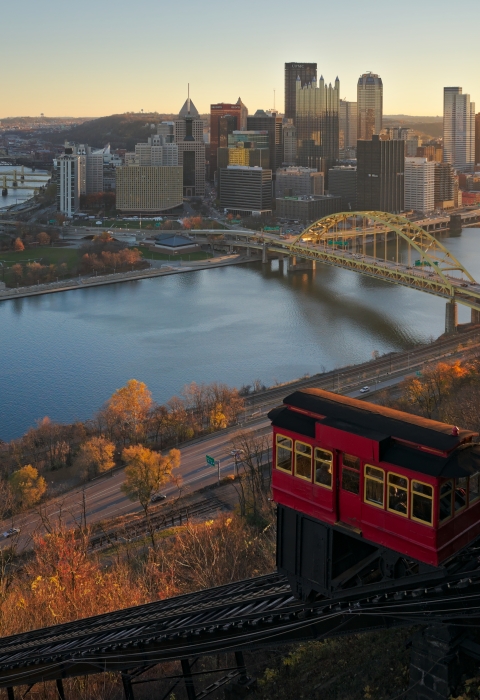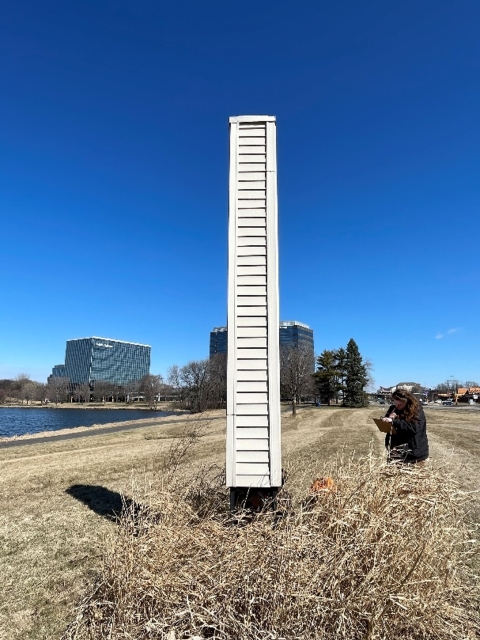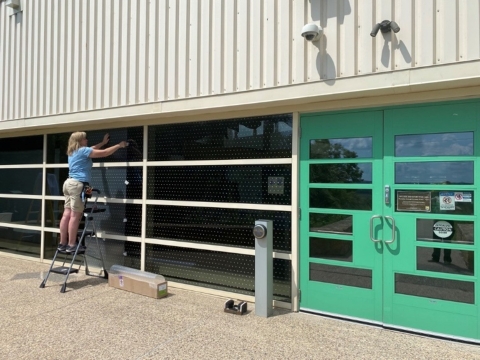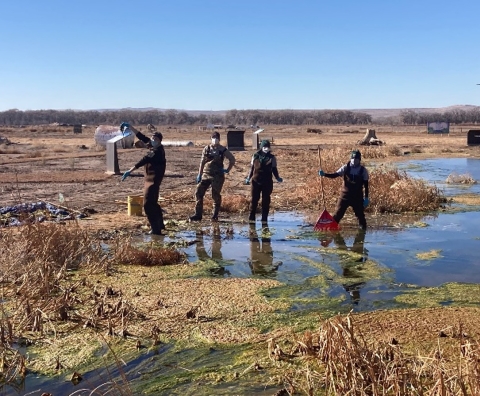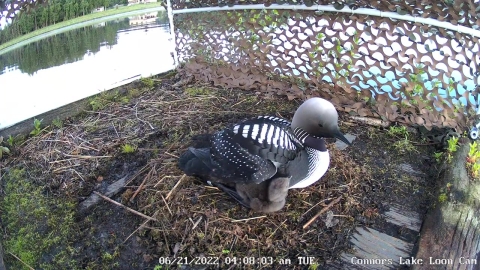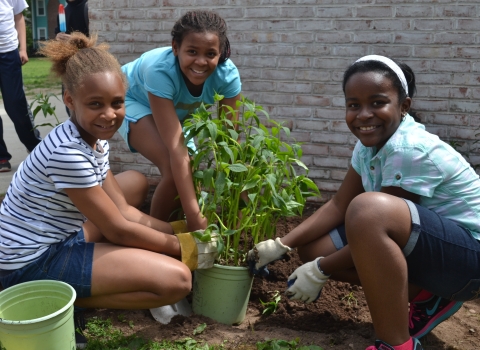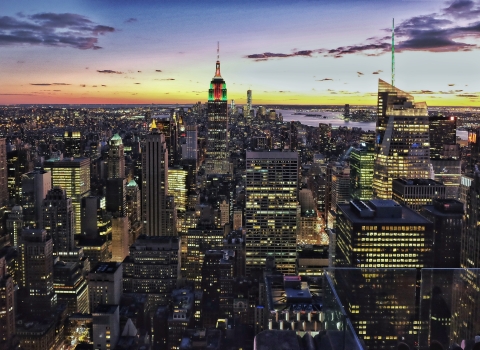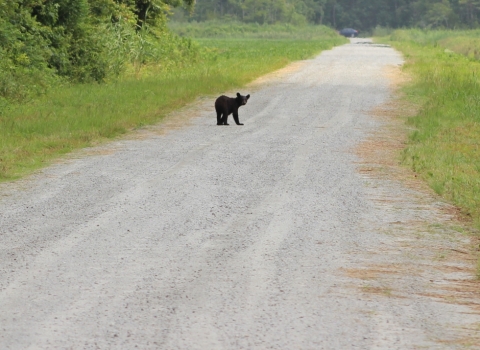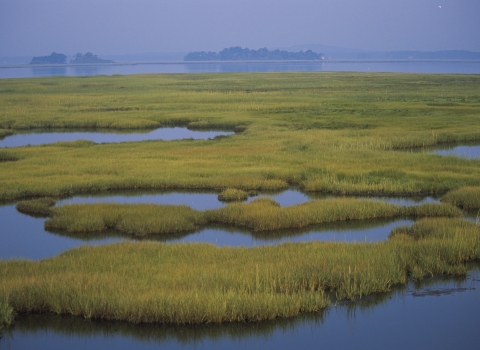Urban Bird Treaty city partnerships have been busy protecting habitat and helping communities deepen their connections to birds! Partners in Albuquerque, NM, Minneapolis/St. Paul, MN, Ogden, UT, and Anchorage, AK, have some great accomplishments to share from all their hard work making these cities healthier places for birds and people.
About the Program
The Urban Bird Treaty program is a unique, collaborative effort between the U.S. Fish and Wildlife Service and participating U.S. municipal governments and other state, federal, and NGO partners. Launched in 1999, the first treaty was signed with New Orleans and the second with Chicago in 2000. Since that time, an additional 28 cities have become Urban Bird Treaty cities, for a total of 30 spanning from Alaska to Alabama. Read about our Urban Bird Treaty cities.
Success in the Twin Cities
Aerial insectivores are those birds that prey on insects while they are flying. Unfortunately, aerial insectivores have the most species in decline of any group of birds with 73% of species in decline. One type of aerial insectivore, the chimney swift, was identified in the 2022 State of the Birds Report as a Tipping Point Species, listed as a Bird of Conservation Concern, and is one of the priorities the U.S. Fish and Wildlife Service is focusing on as part of the Bring Birds Back initiative. Clearly, the severe decline of all aerial insectivores, including chimney swifts, is an issue that the conservation community is coming together to address.
The Twin Cities Urban Bird Partnership in Minnesota has created a chimney swift working group, and partners monitored 12 towers for nesting activity and 6 towers for roosting activity during the summer of 2022. Unfortunately, there was no nesting or roosting activity at any of the towers, indicative of the challenge of building towers that swifts will use— especially in more northern climes—given the decline in natural masonry chimneys. However, the partners hosted a Big Sit at a roosting site in August and visitors got to see 700+ chimney swifts going in and out of a high school chimney! The partnership now has a goal is to host more community events and “Swift Sits” in 2023.
Additional successes in Minneapolis and St. Paul:
- Minnesota Valley National Wildlife Refuge has been installing window treatments at both of their visitor centers to reduce bird strikes. As an urban refuge, they take pride in being an example of urban conservation in the community and encourage their partners and neighbors to join in and reduce bird collisions at their homes and offices!
- After a two-year hiatus, the Urban Bird Festival returned to the Twin Cities! More than 700 members of the public came out to connect with nature, learn about urban birds, and conserve habitat.
- The Urban Bird Collective is a non-profit organization that supports Black, Indigenous, and People of Color (BIPOC) communities and LGBTQ+ birdwatchers of all skill levels, creating safe and welcoming spaces for these communities to explore birding and reap the benefits of being in the outdoors with others. After a successful leadership retreat, training and several outings, the group continues to grow as they inspire their communities to love birds, contribute to urban bird conservation, and encourage stewardship of outdoor spaces.
Success in Albuquerque, NM
Valle de Oro National Wildlife Refuge
in Albuquerque, NM was a former dairy farm and is still in agricultural fields on a majority of the property. The long-term vision is to make the refuge into a mosaic of native Middle Rio Grande Valley habitats and an oasis to both wildlife and people. At this refuge, staff, partners, and the community are collaboratively building a refuge from scratch, keeping in mind wildlife, people, environmental justice, and more.
In 2022, habitat restoration on Valle de Oro National Wildlife Refuge was mainly focused on four key areas of wetlands, playa wetlands, and upland habitat. In total, Valle de Oro staff, partners and community members planted 104,030 trees, shrubs and grasses on the refuge in 2022! Refuge staff and partners including Rio Grande Return worked tirelessly throughout the year to plant and then maintain these transplanted species and prevent invasive plant species from taking over these sensitive areas.
Additional successes in Albuquerque:
- The Albuquerque Backyard Refuge Program supports communities in creating drought-tolerant habitat pockets in their yards, patios, and apartment balconies to benefit both people and wildlife. As of May 2022, they certified over 81acres of backyard habitat with 219 individual and business participants.
- The Bosque Ecosystem Monitoring Program monitors biotic and abiotic dynamics in the Middle Rio Grande bosque ecosystem while meaningfully involving the community and educating students. In 2022, they engaged with over 3,000 students in learning about conservation science, focusing on Title I schools and involved University of New Mexico undergraduate and graduate students in habitat and bosque ecosystem monitoring.
- The City of Albuquerque Open Space Division partnered with the U.S. Fish and Wildlife Service’s Migratory Birds program to create free birding kits available at Albuquerque Public Libraries.
- The Valle de Oro National Wildlife Refuge Visitor Center opened in 2022 and lots of care was put into the design to make it both bird friendly and dark sky friendly. As a part of the LEED (Leadership in Energy and Environmental Design) certification, the Valle de Oro Visitor Center will be one of the first USFWS buildings in the country to get the pilot Bird-Friendly LEED Credit!
Success in Ogden, UT
The L. S. Peery Education Center at the Ogden Nature Center (ONC) is a 7,100 sq. ft. green building with classrooms, teacher preparation areas, and volunteer space for the ONC’s extensive nature education programming—and is a model of sustainable and energy-efficient environmental design. The building also hosts large windows in the classrooms making them aesthetically appealing and more efficient to warm using solar radiation. However, these windows had a serious issue: birds were frequently colliding with them resulting in bird injury and death.
To remedy this issue, in 2020, ONC partnered with Weber State University’s ArtsBridge honors art program and the fourth-grade classes at Shadow Valley Elementary to design a project to reduce window strikes in the Education Center’s classrooms. The fourth-grade students visited ONC to first research native bird species and the habitats they depend on. Afterward, the students set to work drawing different birds in their associated habitats. The artwork was then sent to the ArtsBridge program where university students brought it to life by transferring the images into 60 faux stained-glass panels. The university students further added to the project by etching frosted bird and habitat designs into the top panels of the windows.
In December 2021, the impressive art piece was finished and installed at ONC, effectively reducing bird strikes to nearly zero. To view this inspiring process, please watch the following video put together by the collaborating partners:
The Ogden Nature Center and other Urban Bird Treaty partners also completed several wildlife habitat restoration projects in 2021-2022 by planting a diversity of native shrubs, grasses, wildflowers, and trees. In October 2021 and April 2022 volunteers throughout the Ogden City community joined ONC staff to plant over 600 wetland plugs and 345 upland shrubs around a newly constructed retention pond to create cover and food for wildlife. In September 2022, ONC was joined by a local high school (Waypoint Academy), United Way, and Zion Bank employees to restore a degraded area by planting over 300 upland plants and 50 wetland plants provided by the Utah Pollinator Habitat Program. These native plants were hand-selected to bloom at staggered periods, providing food resources throughout the year to native pollinators and birds.
Success in Anchorage, AK
Did you know that Anchorage, Alaska is the largest city in North America (by population) to have nesting loons?! It’s true! Every year Urban Bird Treaty partners place a loon nesting raft on Connors Lake, not far from the Ted Stevens International Airport, and await the arrival of a pair of Pacific loons. Last year Service staff worked with the Jean Tam Loon Conservation Endowment Fund, led by the Alaska Conservation Foundation, to install a new camouflage canopy and livestream video camera on the raft. The team could then tune in to the livestream to see and hear what was going on. Good news! The handcrafted wooden raft successfully supported the nesting pair and the fledging of a Pacific loon once again.
Additional Successes in Anchorage
- In 2022, the Anchorage Waterways Council and the Anchorage Park Foundation restored a section of habitat along Westchester Lagoon that had been denuded of vegetation by humans. A popular spot for feeding waterfowl and swimming dogs, this problem area was revegetated to reduce bank erosion and reduce human-waterfowl interactions. Approximately 400 sq ft of habitat was restored and a new bird viewing platform installed.
- Staff worked with Alaska Wildlife Conservation Center to build a native plant garden that will benefit pollinators and birds directly while sharing the value of native plants with the public. In summer 2022, 250 square feet of garden was developed. In addition, staff and partners created education resources on native plants and worked with the National Pollinator Partnership to develop a native plant garden card for Alaska. More than 1,000 copies of this garden card were distributed at educational events around Anchorage.
- Staff worked with the Alaska Wildlife Conservation Center and other partners to host "Summer Hummingbird Days" to celebrate Alaska's hummingbirds, using them as charismatic ambassadors to spread broad bird conservation messaging. The event reaches 1,000 people every year. In summer 2022, the event was expanded to specifically target Anchorage urban youth through an additional partnership with Anchorage's Boys and Girls Clubs.
